
Updating Training Materials Quickly and Efficiently
UPDATING TRAINING MATERIALS QUICKLY AND EFFICIENTLY
If you have ever managed a company, you know that training materials are a necessity. However, ensuring that those training materials are up-to-date can be an overwhelming task.
Medium- and large-size organizations face content consistency challenges all the time. We know that overcoming these challenges may feel like an uphill battle or a backburner project constantly overshadowed by more urgent needs, but it does not have to be so difficult. With the right strategies, updating, and more importantly, maintaining your training content can become easier, faster, and more efficient.
But, how do you get started?
Cross-Referencing
First things first, you have to take stock of all the training materials and Standard Operating Procedures (SOPs) you have. Once you have located all of your SOPs and training materials, you need to figure out which SOPs are referenced by which training materials and record this information in a clear, usable way. Knowing exactly which SOPs are referenced where can make the updating process significantly faster and easier. There are a couple of ways to do this, and it can be useful to incorporate both methods.
Reference Language and Inline Citations
It’s a best practice across all fields and types of content to keep references to outside documents relatively high-level and exclude specific information that’s likely to change often. This elimination of specific content will reduce the number and frequency of required updates in your training materials. Reference language and inline citations are extremely useful because they can provide specific yet brief cross-reference information.
For example, if a certain department has training materials that talk about travel policies and expenses, those training materials should exclude specific information that’s included in the SOP, such as rates, and just refer the trainees to the travel SOP. The training content can contain simple reference language such as “See SOP 2.1.4 Travel and Expenses for further details including rates.”
Inline citations serve the same purpose but use an even shorter format. Training material covering travel policies and expenses can contain specific policy information in parentheses or brackets that usually appear at the end of sentences or paragraphs. For example, a bullet point or paragraph about travel reimbursement could be followed with a citation like this: [SOP 2.1.4 Travel and Expenses]. This citation tells the reader where more information can be found and the content manager(s) exactly which SOP is associated with this content.
Tagging
While references and inline citations are useful when you’re looking at each document individually, you also need an easy way to find all training materials that reference a particular SOP. If SOP 2.1.4 is updated, you don’t want to have to read through every training document searching for references and citations to see which of the documents need changing as a result. You want to glance at a file and know which SOPs it references and be able to search and find all documents that reference a particular SOP.
A great solution that allows you to search for particular content across numerous documents is a tagging system. You can create meaningful tags, or labels, that can be searched and sorted and attach these tags to your documents. Tagging is a relatively simple yet extremely useful bit of technology that can save many a headache and hassle. As Zapier.com puts it, “With a couple of tags, you can instantly categorize and label files for hassle-free searches down the road, and then find all of those files again easily no matter where you save them.”
Let’s say that the sales department’s Business Travel Training Handbook is 30 pages long and contains multiple references to SOP 2.1.4 Travel and Expenses. It could even contain references to other SOPs. You don’t look forward to reading through a 30-page document (or your other 10 training materials) just to find out if you need to make changes to them. And you won’t have to if you add a reference tag to the Business Travel Training Handbook.
In Microsoft Word, for example, you can create these tags by editing the metadata (information associated with the document that isn’t part of the document’s actual content or filename).
Adding a Tag to an Open Word Document:
Click on the “File” tab in the top left (blue in the screenshot below). Then click on “Info” (in the left column under “File,” also blue in the screenshot below). In the far right column, look under “Properties” and find “Tags.” Click on the field beside “Tags” (it will say “Add a tag” before you click) and type in your tag name (in the orange circle in screenshot below).
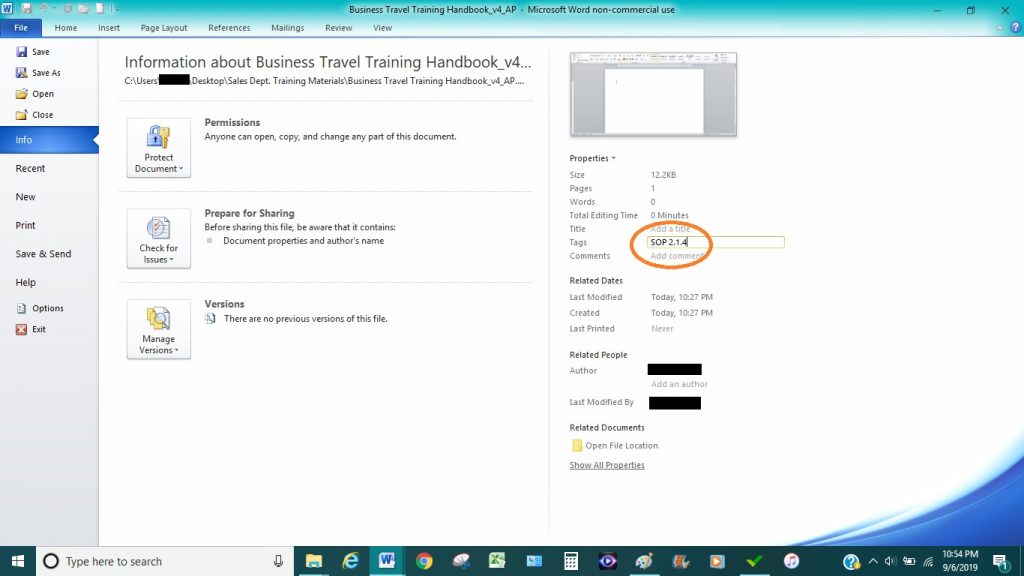
You can also add a tag while you’re saving a document. After you click on “File” and “Save As,” you can click on “Add a tag” in the pop-up box (in orange circle in screenshot below) and add your tag before you save the document.
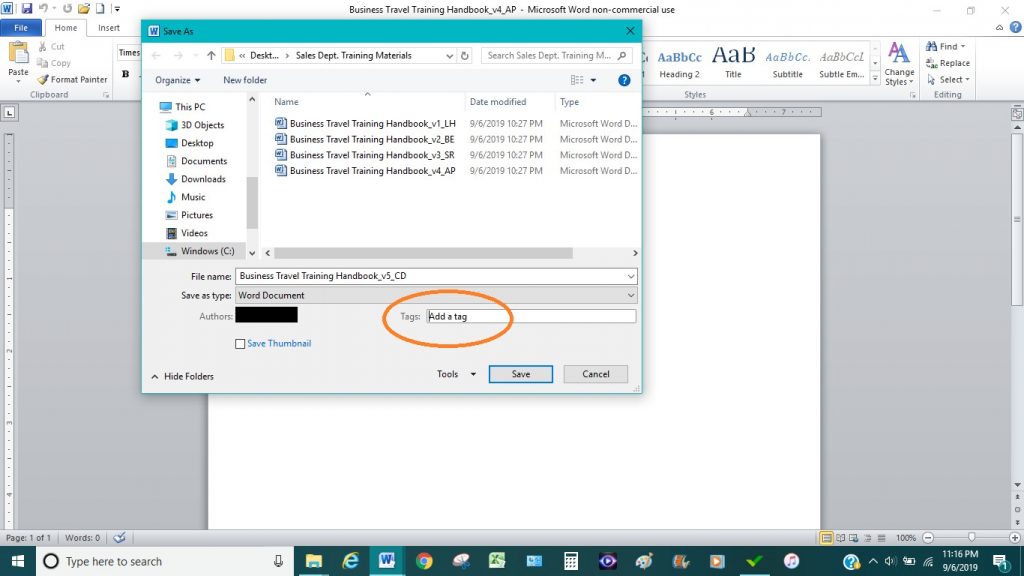
Adding a Tag to a Closed Word Document:
Right-click on the file you want to add the tag to and click on “Properties.”
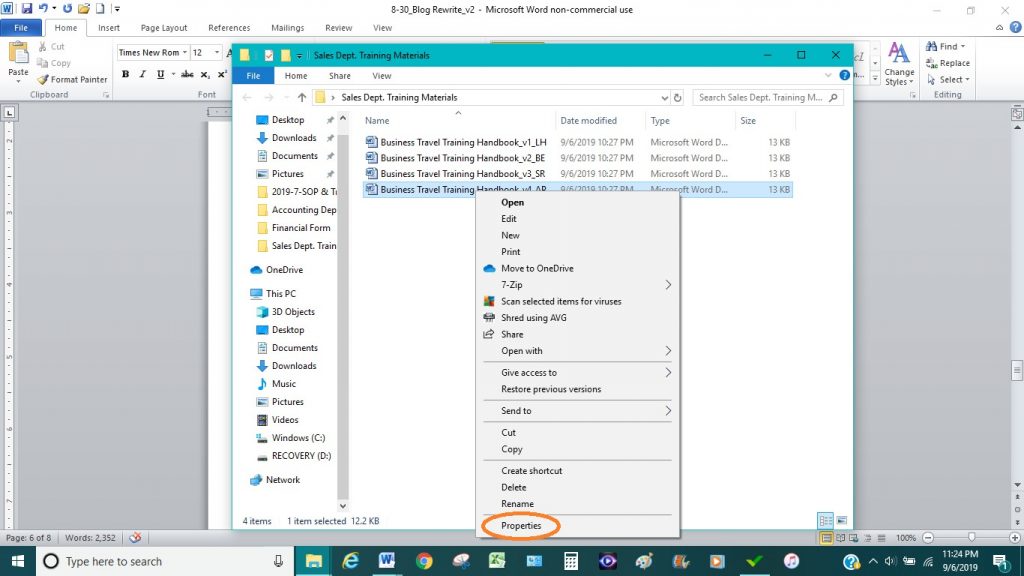
Then click on the “Details” tab (in orange circle), click beside “Tags” (in blue), and type in your tag name.
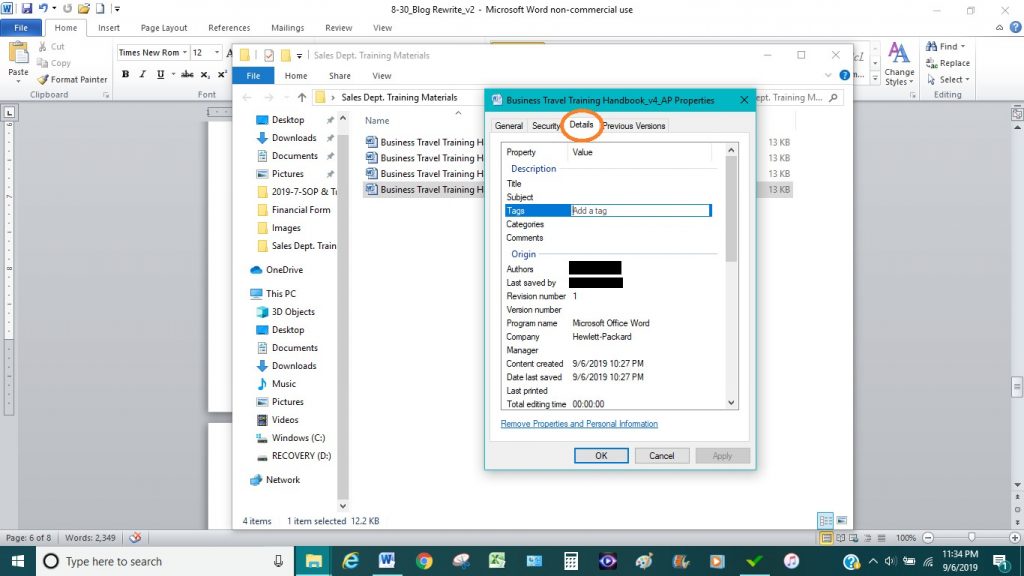
You can also use any of these methods to remove a tag—just delete the tag name.
How to Search for a Tag:
Now that your training documents are tagged with all of the SOPs they reference, how do you use the tags to find what you need? When SOP 2.1.4 is updated, how do you find all of the training documents that reference it and may need updating?
Quickly and easily, that’s how!
First, make sure that the “Tags” column is displaying in File Explorer. Right-click at the top where the other column names appear and make sure there’s a checkmark beside “Tags” (or click to add the checkmark).
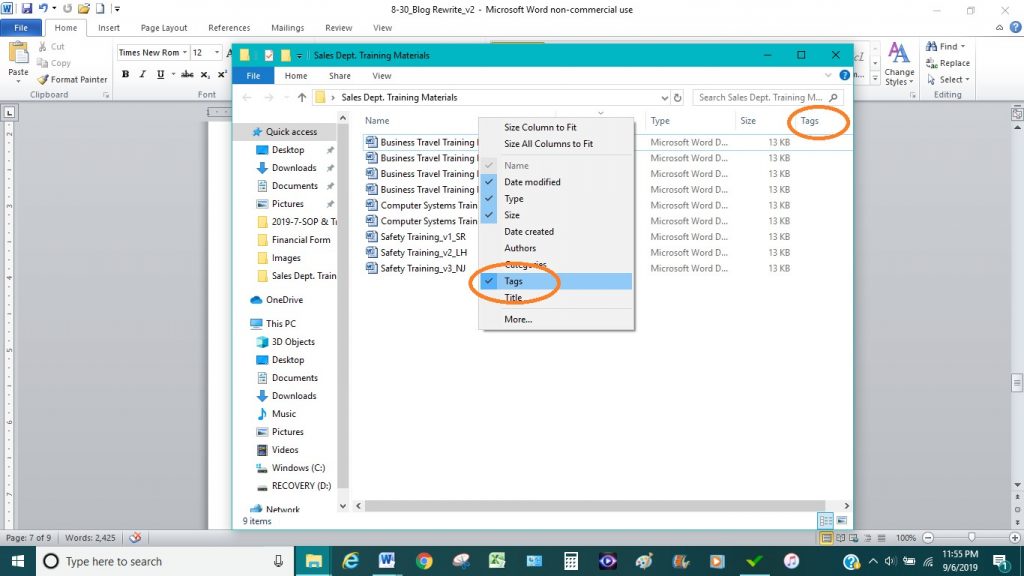
Now you can search for files you need. Click on the down arrow/carrot beside “Tags,” and a list containing all of the tags in use appears.
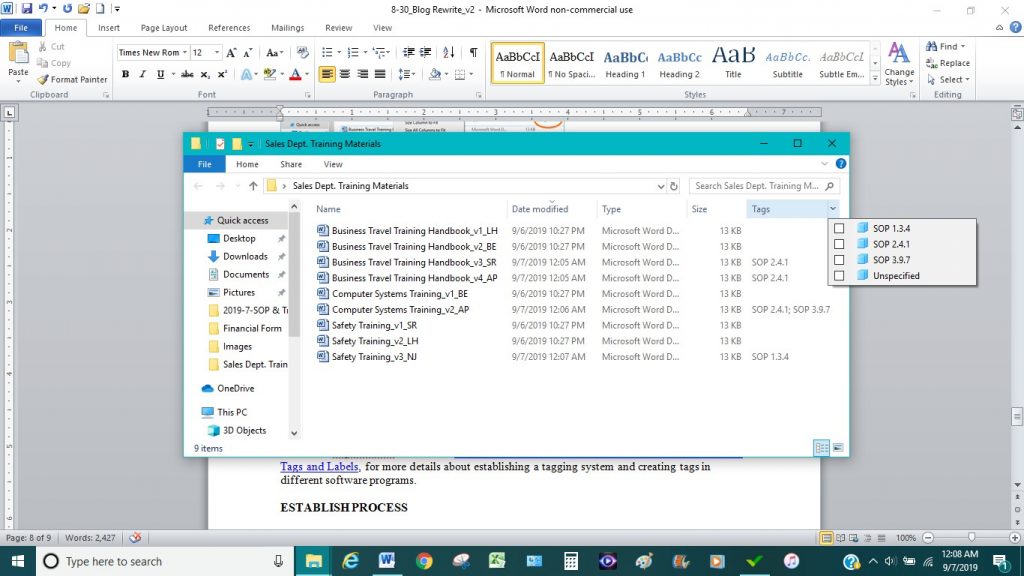
Now check the box beside the SOP tag(s) you want to search for. If SOP 2.4.1 has just been updated, then you’ll want to find everything tagged with “SOP 2.4.1.” When you select this tag, every document with the tag shows up.
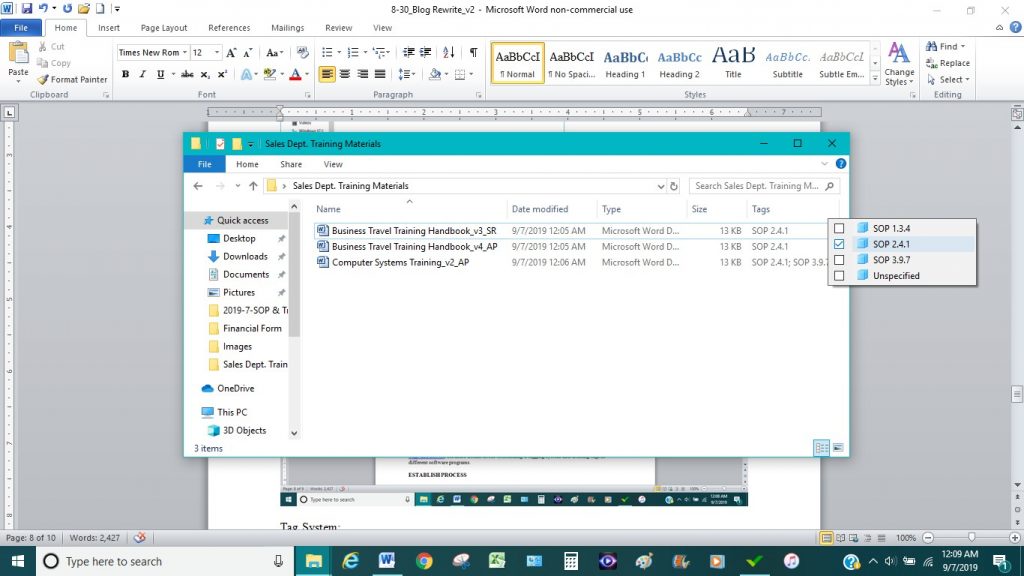
Useful Note: If you select more than one tag in your search, any document with at least one of the tags will show up. Say you selected “SOP 2.4.1” and “SOP.1.3.4.” The documents that show up could contain either tag or both tags. In other words, this search wouldn’t exclude documents that only have one of the tags.
Tag System:
You’ll need to establish some rules/follow some best practices for your tag system, or things could quickly get out of control and super disorganized (not to mention confusing).
For example, you’ll want to establish a standard for creating tag names (similar to your file name standard). If there isn’t a standard way to name a tag, you could end up with several different tags that mean the same thing. “SOP 2.4.1,” “2.4.1,” “SOP 2.1.4 Travel and Expenses,” “Travel and Expenses,” “Travel and Expenses SOP,” and “2.4.1 Travel” are just a few examples of that tags that people might create without instructions.
You may also want to think about limiting what tags can be created for (SOP references only, all external document references, etc.), creating a running list of tags being used, and assigning one person or a select few to create tags or allowing the entire department to create tags. The more people involved, the clearer and stricter the rules need to be in order to maintain organization and clarity and avoid repetition.
Check out Zapier.com’s full article, Forget Folders: The Best Ways to Organize Your Files with Tags and Labels, for more details about establishing a tagging system and creating tags in different software programs.
ESTABLISH PROCESSES
Now that you’ve gathered and organized all of your training materials in one place and cross-referenced them with any relevant SOPs (and other external documents), it’s time to establish your processes.
Review of Organization Processes
You begin establishing processes and conventions/best practices during the organization phase by establishing cross-referencing and tagging systems.
These organization-based processes lay the foundation for successful content management. The next processes that need creating and implementing will determine how this newly organized content is managed—immediate updating, regular review cycles, etc.
Immediate Update and Review Cycle Processes
Now that you have established processes, it’s time to decide who has which role(s), what will happen and in what order, and when it will happen.
Immediate updates should be triggered by SOP updates. As soon as you know that an SOP has been updated, newly added, or removed, you need to see if any of your training documents may be affected and make any necessary updates.
You have to decide who is responsible for checking the training documents when an SOP is updated, who will read through the document(s) to find what needs changing, who will make the changes, and if someone else will review the document to ensure that the changes made are accurate and well-written.
Will tracking changes in a document and saving a new version of the document be sufficient record keeping?
When it comes to establishing a regular review process, you have to ask and answer many more questions, such as:
Who will be in charge of reviewing the training material? Will all of the documents be reviewed together by one person and passed along to another person for a second review? Is there a technical writer in the company who is available to lend assistance?
Will there be a regular review? Do certain training materials need reviewing more often than others?
Who will kick off this process at the beginning of each review cycle, and what will the process entail? Will reviewers and editors follow a checklist?
And how is all of this going to happen? Back and forth in a hundred emails or by using a project management system like Wrike or Trello (or the many others out there)?
A Quick Note About Technical Writers
All of this can sound (and become) overwhelming even if you don’t have a ton of training content. This is where a technical writer can make a huge impact.
Many larger companies have a technical writer on staff, and those who don’t could definitely benefit from hiring one. Technical writers can be a central resource within the company for all kinds of content and documentation. They can help departments and/or entire companies develop efficient processes, assist with reviews and writing/editing, create templates to help everyone get organized and relatively consistent (or just started in the first place), and help maintain consistency and improve quality across the company.
Maintain Communication
Establishing processes is essential, but all of that hard work will amount to little or nothing without implementation. And the key to implementation is effective communication. This is another area in which technology, including project management software, can be helpful.
SOP Owners
It’s a good idea to maintain communication with the people in charge of the SOPs. If changes in SOPs don’t trigger department or company-wide training, an email should at least be sent out to inform people about the update. After all, if you don’t know when an SOP is updated, you won’t know to check and update your training materials.
Between Departments
Departments can share useful information about SOP updates they’ve heard about, their training updating processes, their file organization systems and departmental roles, and ideas for collaboration and establishing consistency with other departments. Establishing productive relationships with as many departments and colleagues as possible can help many things run more smoothly, and adult peers tend to learn well when they learn from each other.
Within Departments
This is probably the most important aspect of communication because the processes are likely taking place entirely within the department. For that reason, it’s a good idea to provide one or more training sessions on the new processes and rules/standards. When everyone understands the responsibilities, steps, expectations, and smaller details involved, training materials will get updated more quickly and can be maintained more easily. It’s also important to consistently provide updates on process and responsibility changes to keep things running smoothly and obtain feedback in order to continuously improve processes and standards.
Technical Writer
Finally, if there’s a technical writer in the mix, maintaining communication with him/her can be extremely helpful. A technical writer can help with writing, editing, consistency, and creating and improving processes. They are also skilled at involving others in the process, keeping people on-task, and trying to hold people accountable to deadlines.
Ready, Set, …Oh, It’s Already Done?
Updating and maintaining current training materials is a big task that often gets pushed to the wayside, but by getting and staying organized, establishing and consistently following processes, and maintaining effective communication, you can update your training materials quickly and efficiently anytime an SOP is updated. Now that you can do it like a pro, you can use that extra time to do something else productive, like savoring your training content management victory.
Related Content
- 0 Comment
Subscribe to Newsletter
- How Can SharePoint Be Used To Organize and Disseminate SOPs?
- Planning the Perfect Genealogy Research Trip: A Step-by-Step Guide
- From Silly to Awesome: How Words Change Meaning Over Time
- The Psychology of Font Choice: How Typography Impacts Content Engagement
- How to Distribute SOPs for Maximum Usability



